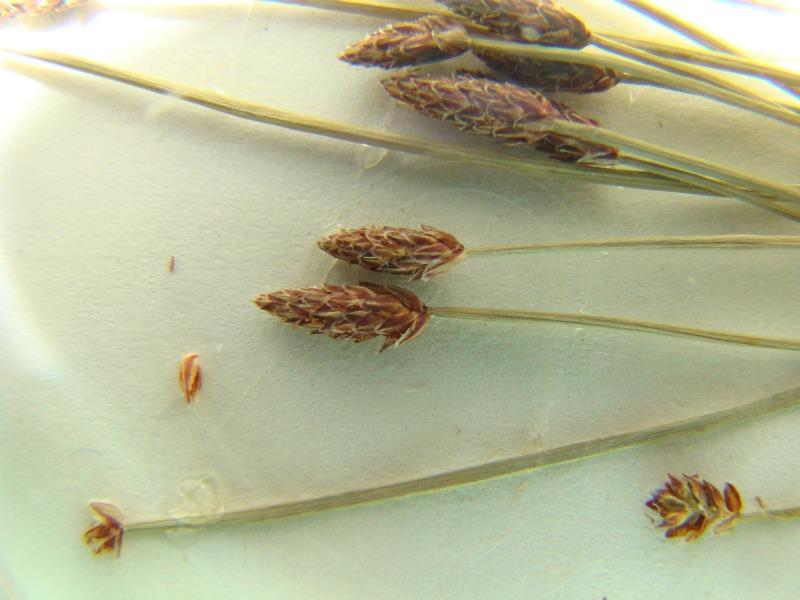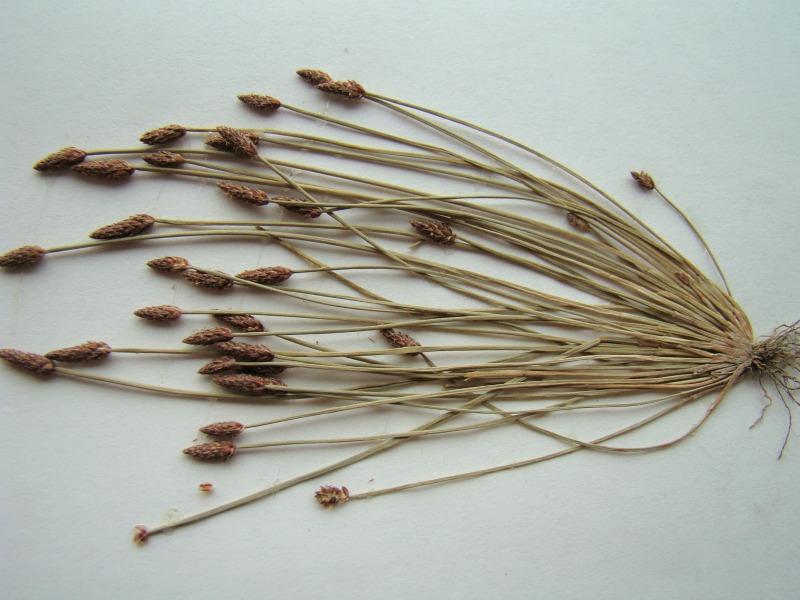Engelmann's Spike Rush
Eleocharis engelmannii Steud.
- Class
- Monocotyledoneae (Monocots)
- Family
- Cyperaceae (Sedge Family)
- State Protection
- Endangered
Listed as Endangered by New York State: in imminent danger of extirpation in New York. For animals, taking, importation, transportation, or possession is prohibited, except under license or permit. For plants, removal or damage without the consent of the landowner is prohibited.
- Federal Protection
- Not Listed
- State Conservation Status Rank
- S1
Critically Imperiled in New York - Especially vulnerable to disappearing from New York due to extreme rarity or other factors; typically 5 or fewer populations or locations in New York, very few individuals, very restricted range, very few remaining acres (or miles of stream), and/or very steep declines.
- Global Conservation Status Rank
- G4G5
Apparently or Demonstrably Secure globally - Uncommon to common in the world, but not rare; usually widespread, but may be rare in some parts of its range; possibly some cause for long-term concern due to declines or other factors. More information is needed to assign either G4 or G5.
Summary
Did you know?
The species name honors George Engelmann, 19th century German-born botanist, who became famous for his plant studies in the Rocky Mountains in northern Mexico and the discoverer of this species of spikerush. He was also the first to study American vines in detail and helped the French recover their wine industry by providing fungus-resistant grapevines from the United States (George Engelmann in Wikipedia, accessed 1 May 2009). This plant has only ever been found in a few scattered locations on Long Island and New York City area with one outlier at Kinderhook Lake in Columbia County. No sightings were made between 1946 in 1985 when it was rediscovered at Lake Ronkonkoma on Long Island.
State Ranking Justification
There are only two existing populations with less than 50 plants each. One of them is in an area that is highly developed. There are 11 populations from the late 1800s and early 1900s but about half of these are gone because their habitat has been destroyed. Five of these populations need to be rechecked.
Short-term Trends
Short-term trends are unknown because the known populations have not been rechecked.
Long-term Trends
Long-term trends are in decline since six of the 11 known historical locations have been destroyed and only two existing populations are known.
Conservation and Management
Threats
One population is threatened by surrounding development and the alteration of its hydrology and water quality.
Conservation Strategies and Management Practices
A wetland buffer needs to be established to prevent degradation of water quality and to maintain the hydrology of the site.
Research Needs
Research is needed to find the habitat preference for this species in order to augment populations.
Habitat
Habitat
The few New York collections of Engelmann's Spikerush have been from pond margins, usually with exposed peaty or mucky substrates (New York Natural Heritage Program 2010). Fresh shores, marshes, disturbed places (FNA 2002). Marshes and wet places (Gleason & Cronquist 1991). Wet sand, peat or mud (Fernald 1970).
Associated Ecological Communities
- Coastal plain pond shore
(guide)
The gently sloping shore of a coastal plain pond with seasonally and annually fluctuating water levels. Plants growing on the pond shore vary with water levels. In dry years when water levels are low there is often a dense growth of annual sedges, grasses, and herbs. Submerged and floating-leaved aquatic plants, such as fragrant waterlily and pondweeds, may become "stranded" on the exposed shore. In wet years when the water level is high only a few emergents and floating-leaved aquatics may be noticeable. T
- Freshwater intertidal shore*
(guide)
A community of the intertidal gravelly or rocky shores of freshwater tidal rivers and creeks, sometimes occurring at the base of cliffs. The vegetation may be very sparse.
- Freshwater tidal marsh*
(guide)
A marsh community that occurs in shallow bays, shoals, and at the mouth of tributaries of large tidal river systems, where the water is usually fresh (salinity less than 0.5 ppt), and less than 2 m (6 ft) deep at high tide. Typically there are two zones in a freshwater tidal marsh: a low-elevation area dominated by short, broadleaf emergents bordering mudflats or open water, and a slightly higher-elevation area dominated by tall grass-like plants.
- Freshwater tidal swamp*
(guide)
A forested or shrub-dominated tidal wetland that occurs in lowlands along large river systems characterized by gentle slope gradients coupled with tidal influence over considerable distances. The swamp substrate is always wet and is subject to semidiurnal flooding by fresh tidal water (salinity less than 0.5 ppt).
* probable association but not confirmed.
Associated Species
- Cyperus
- Fuirena pumila (dwarf umbrella-grass)
Range
New York State Distribution
There are known locations only in Suffolk County including Fishers Island but this spikerush was originally known from all of Long Island and the Bronx with a disjunct population in Columbia County.
Global Distribution
This spikerush occurs across central Canada from Alberta to Ontario and is widespread in the United States from Washington to Maine (historical) south to California and Georgia. It is uncommon in the southern tier of states (and absent from Florida) and in the Northeast where it occurs in a handful of counties from New York, Connecticut, and Massachusetts to western Maine.
Identification Comments
General Description
Spikerushes are graminoid (grass-like) plants which consist of a simple stem (the leaves bladeless and inconspicuous) with an infloresence of a solitary, many-scaled spikelet at the top. The perianth (sepals and petals), if present, is reduced to (usually 3 or 6) bristles. The base of the style expands into a tubercle, and is usually persistent on the fruit (achenes). Englemann's spikerush may be from 2 to 40 cm tall, the stems often spreading or declining. The distal leaf sheath is persistent, with a tooth up to 0.3mm long. The spikelets are lance-shaped to cylindrical or ellipsoid and 5 to 10 mm long, and the floral scales orange brown to straw-colored with a keeled middle vein except for a green midrib. There may be 5 to 8 perianth bristles, or sometimes none. The achenes are .9 to 1.1 mm long. The tubercle is strongly depressed, triangular, and less than ¼ the height of the achene (FNA 2002).
Best Life Stage for Proper Identification
Specimens with mature fruit (tubercles) are needed for identification.
Similar Species
Eleocharis diandra's spikelets lack bristles and have acute floral scales. E. obtusa, E. ovata, and E. aestuum have bristles which overtop the tubercle and their tubercles are more than 1/4 as tall as the achenes (FNA 2002). Eleocharis has subacute or rounded floral scales, it's bristles (if present) are shorter than the tubercle, and its tubercles are less than 1/4 the height of the achenes.
Best Time to See
Fruits first mature in late August and persist to mid-October.
- Fruiting
The time of year you would expect to find Engelmann's Spike Rush fruiting in New York.
Engelmann's Spike Rush Images
Taxonomy
Engelmann's Spike Rush
Eleocharis engelmannii Steud.
- Kingdom Plantae
- Phylum Anthophyta
- Class Monocotyledoneae
(Monocots)
- Order Cyperales
- Family Cyperaceae (Sedge Family)
- Order Cyperales
- Class Monocotyledoneae
(Monocots)
- Phylum Anthophyta
Additional Common Names
- Spikerush
Synonyms
- Eleocharis obtusa var. detonsa (Gray) Drapalik & Mohlenbrock
Additional Resources
References
Fernald, M. L. 1950. Gray's manual of botany. 8th edition. Corrected printing (1970). D. Van Nostrand Company, New York. 1632 pp.
Flora of North America Editorial Committee. 2002. Flora of North America, North of Mexico. Volume 23. Magnoliophyta: Commelinidae (in part): Cyperaceae. Oxford University Press, New York. 608 pp.
Gleason, Henry A. and A. Cronquist. 1991. Manual of Vascular Plants of Northeastern United States and Adjacent Canada. The New York Botanical Garden, Bronx, New York. 910 pp.
Great Plains Flora Association (R.L. McGregor, coordinator; T.M. Barkley, ed., R.E. Brooks and E.K. Schofield, associate eds.). 1986. Flora of the Great Plains. University Press of Kansas, Lawrence, Kansas. 1392 pp.
Holmgren, Noel. 1998. The Illustrated Companion to Gleason and Cronquist's Manual. Illustrations of the Vascular Plants of Northeastern United States and Adjacent Canada. The New York Botanical Garden, Bronx, New York.
Maher, R. V., G. W. Argus, V. Harms and J. Hudson. 1979. The rare vascular plants of Saskatchewan. Issued as Syllogeus No. 20. National Museum of Natural Sciences, Ottawa, Canada. 138 pp.
Mitchell, Richard S. and Gordon C. Tucker. 1997. Revised Checklist of New York State Plants. Contributions to a Flora of New York State. Checklist IV. Bulletin No. 490. New York State Museum. Albany, NY. 400 pp.
New York Natural Heritage Program. 2010. Biotics database. New York Natural Heritage Program. New York State Department of Environmental Conservation. Albany, NY.
New York Natural Heritage Program. 2024. New York Natural Heritage Program Databases. Albany, NY.
Weldy, T. and D. Werier. 2010. New York flora atlas. [S.M. Landry, K.N. Campbell, and L.D. Mabe (original application development), Florida Center for Community Design and Research http://www.fccdr.usf.edu/. University of South Florida http://www.usf.edu/]. New York Flora Association http://newyork.plantatlas.usf.edu/, Albany, New York
Links
About This Guide
This guide was authored by: Stephen M. Young and Richard M. Ring
Information for this guide was last updated on: January 24, 2012
Please cite this page as:
New York Natural Heritage Program. 2024.
Online Conservation Guide for
Eleocharis engelmannii.
Available from: https://guides.nynhp.org/engelmanns-spike-rush/.
Accessed July 27, 2024.


